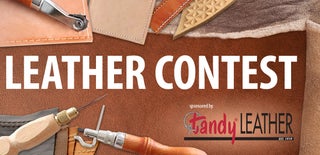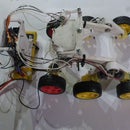Introduction: Steampunk Plague Doctor Mask
Historically, plague doctors were hired by the government to treat the Bubonic plague. The creepy outfits were meant to protect against Miasma, or foul air, that was thought to cause sickness at the time. The idea was that herbs would be kept in the "beak" to purify the stale air. Sadly, plague doctors aren't very common costumes but they do pop up in videogames and things (Shovel Knight and I think there was one in Assassin's Creed) I made this mask with a lot of help from the people at Tandy Leather so some credit goes to them as well. Keep in mind that I made this instructable after I made the mask and I barely documented the construction process so I recommend using this instructable in conjunction with some other, more general, leather working instructions (some of the steps are simplified or unspecific because I don't know how work with leather properly, nor do I have the tools to do so). That being said, the mask came out excellent and was surprisingly easy so I hope to inspire some new mask designs.
Step 1: Tools/Materials
Mask:
- Leather Punch (there are several different kinds but most should work, mine's a rotary punch I think)
- Wooden Hammer
- Rivet Setter and Anvil
- Rivets (mine were listed as "steel double cap rivets")
- Leather (I used stomach leather, I don't know the technical term for it, ask your leather supplier for mask making leather)
- Leather dye (do some research on what dyes to use with your leather, there's a lot to know but keep in mind that black is the easiest dye to use)
- Leather finish (optional, same comment as above)
- Scissors (There are leather scissors but normal paper ones will work)
- Knife of some sort (you really just need some way to cut out the eye holes, there are tools specifically for cutting leather but I don't have any)
- Baking Sheet
- Parchment Paper
- Any other leather working tool that you choose to use (optional, again, there is a ton of information on this and, frankly, I know very little about it so consider looking into specialized tools)
Goggles:
This instructable is more about the mask itself. Goggles aren't strictly necessary but do look cool. I think steampunk is the best. I won't say anything more here but there will be a step on them later on.
Step 2: Pattern
I've included a pattern (the one I made and used for the mask shown here) that I like and I think looks good with the my steampunk goggles. I recommend using mine for a reference and making your own. Patterns for masks (for me at least) are surprising easy to design. If you're wearing the mask with a costume. then design a pattern that matches with the rest of your outfit. You'll want to cut the pattern out of cardstock or some other form of thick paper. Lay the pattern out on your leather and trace it with a scoring tool (any semi-sharp, pointed object will do). Cut out the leather with leather shears (if you have them) or a pair of scissors.
Attachments
Step 3: Forming and Punching
Take your mask pieces and get them wet (room temperature water is fine). The piece should be wet but not soaked. Just get it wet to the point that it becomes easily pliable but not floppy. Make sure to get the leather curved for the beak. Fold it in half and then stretch it until you get a nice curved beak. For the face part, hold it up to your own face (or the face of the person meant to wear it) and form the leather around it paying close attention to the bridge of the nose. Punch holes on one of the pieces meant to be joined by rivets. Hold the second piece to be riveted up to the first and mark the holes with a scoring tool. Punch the matching set of holes and repeat on all other joints. Insert the larger of the two rivet pieces in each hole and see if they line up. If they don't, just stretch the leather until they do. If you want goggles, insert them now while you can still cut or stretch the leather to fit them. If you plan to leave the goggles alone for a long period of time (like overnight), leave the goggles in to prevent the leather from shrinking as it dries.
Step 4: Baking/Drying
At this point you have two options, bake the leather, or let it air dry. I know nothing about air drying leather so I will say no more on the matter other that it doesn't come out as hard as baking it, however it is less likely to damage the leather. If you are baking the leather, set your oven to the lowest setting (mine was 170 degrees Fahrenheit). Remove all metal pieces such as rivets and goggles as they will burn the leather. Note: at this point your leather will still be wet, if it isn't, the leather won't dry as hard as it could be (this is just from my experience, yours may be different). Mine wasn't very wet so it came out somewhat soft. Leather can be baked to almost a wood level of hardness. Bake your leather on a cookie sheet with a layer or two of parchment paper to prevent burning. Check on your leather frequently to make sure it isn't burning. Also check to see if it has dried out. Bake until it feels dry and then bake it some more to get out any remaining water. My leather took about three hours to dry out (though I baked it longer to try to get it to harden more, it never did) but it wasn't very wet to begin with.
Step 5: Dyeing and Finishing
Dyeing with black dye is easy. Other dye is more difficult because you have to get the distribution right. If you choose to use a color other than black, find a dedicated dyeing tutorial, there are quite a few out there. If you do use black, simply follow the instructions on the bottle. It may take several coats. Additionally, the surface of the leather can be moistened slightly before application of the dye to allow for better distribution. Finish is applied similarly but may not be required or desired for the leather you use. Wear gloves and use in a well ventilated area.
Step 6: Riveting
After the dye and finish has dried begin riveting. Actually, PRACTICE, then begin riveting. Alright so riveting isn't really all that hard but try it a few time on some scrap leather before you rivet the mask. You can also heat up the rivets (FIRE!!!!!) to get a nice, tarnished look. keep in mind that this will remove a coating from the rivets, causing them to be more susceptible to rust. Insert the longer rivet piece up through the underside of both pieces of leather. The cap snaps on fairly easily. Put the bottom rivet piece over the rounded side of the rivet anvil (metal bowl looking thing) and hold the rounded piece of the rivet setter (metal stick, punch thing) to the top of the rivet. Tap the rivet setter with a wooden hammer until the rivet is fairly snug in the leather. Repeat with all other rivets. You will probably want to do this over the edge of a table to get the rivet anvil under the leather. Remember the order is rivet anvil, long rivet, leather, leather, rivet cap, rivet setter, hammer. I also riveted on a velcro strap I had laying around but string would work just as well.
Step 7: A Note on Goggles
My goggles took two attempts to make. Version 1 was made with sheet brass, copper tubing and some weird brass fitting. They sucked, a lot. My second attempt was made with sheet brass, a piece of copper pipe, brass rods, and copper nails (ok, so they were copper coated nails but I'm cheap so whatever) and they were awesome. I tried to make my goggles look steampunk because I think that style looks cool. Plague doctor masks look just as good without goggles so if you can't make or afford them just leave the eye holes empty.
Step 8: Conclusion
Yeah, that's about all I've got. The mask probably cost me around $100 (including the price of the goggles which was around $30) but I was starting from scratch and was rushed. If you scrounge up the metal and improvise with tools you could probably make the mask with about $40 dollars. I made the mask in about four days but it could be done in less. I apologize for the poor photography and hope to get some good feedback. Vote for me in the leather contest!

Participated in the
Leather Contest

Participated in the
Halloween Costume Contest 2015














